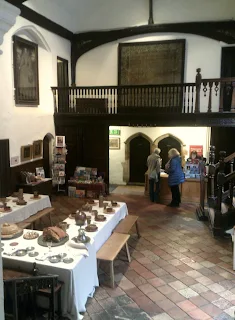Strangers' Hall is a museum of domestic history and dates back to the 1320s, when Ralph de Middleton owned a house on this site. It is thought that the undercroft was built then, to store and possibly display merchandise.
It was a home to wealthy merchants, mayors and various others- including a solicitor and a dance master- when Norwich was in its heyday. Many parts have been added to its structure since and the property now consists of an extremely interesting and eclectic maze of rooms.
It takes its name from the time of Norwich grocer and mayor, Thomas Sotherton, who resided in the house in the 16th century. The first 'strangers' were Dutch, Walloon (French-speaking people of southern Belgium) and Flemish refugee workers, forced to flee the low countries as a result of the persecution of Dutch Calvinists by their Spanish, Catholic rulers. The asylum seekers were weavers, and Sotherton was keen to encourage them to reside in Norwich, believing that their invaluable skills could be well-utilized. Time would prove him correct, and they brought much prosperity to the area. Documents survive which show that some may have lodged at Strangers' Hall.
In 1899, local solicitor Leonard Bolingbroke bought the empty and neglected building and furnished it with his own antiques. In 1922 he presented the museum to the City of Norwich.
Strangers' Hall is not open all of the time (Wednesdays and Sundays) but it only costs £1.50 to visit if you pop in during the last hour.
It is a bit of a haphazard mish-mash inside, and the layout seems to have no rhyme or reason (talk about 'upstairs, downstairs and in m'lady's chamber') but it's far from boring!
You enter via the Great Hall, which was believed to have been built when mercer (cloth merchant) William Bailey lived here, in the 15th century. Leading citizens were expected to entertain lavishly.
This is a view from the balcony, which you can see in the previous photo.
Francis Cock installed the Walnut Room in 1627. Walnut gave furniture a richness that was much in demand at the time. Rooms like these allow families to display their fine possessions.
I appear to have a ghostly SuperDean in this photo!
The view from the other corner...
Vain Old Tart, bedraggled from travelling that day!
Lady Paine's 17th century bedroom. Her husband, Sir Joseph Paine, was a wealthy city hosier who lived at the hall between 1659 and 1667. He was mayor when Norwich declared its support for Charles II, in 1660.
There is a tapestry on display at the end of the bed...
And a Vain Old Tart on display in the mirror...
The Little Bedchamber. Perhaps this was a maid's room? They are not quite sure.
The Great Chamber, displayed as Sir Joseph Paine's private chamber. The floorboards are incredibly creaky- there would be no sneaking in unnoticed in this house!
Great Chamber fireplace...
Pretty knot garden view from the window...
This cabinet of jugs is on the staircase down...
The Georgian Room was installed in 1748, when Strangers' Hall became the official lodging place of Assize Judges, who regularly came to the city to attend court cases. It is much lighter and airier than the rooms upstairs.
The view down into the knot garden from here is perhaps more picturesque. The garden contains plants used for medicinal, culinary and textile-related uses...
The chandelier is stunning...
The Vain Old Tart is not so bad either...
The Music Room.
The harp. This photo is not the best, I'm afraid.
V.O.T.
The Parlour. Another less than brilliant photo, methinks.
The next room is decorated with display cabinets featuring children's toys...
The Victorian Nursery...
The Victorian Parlour was presided over by the mistress, and was considered to be the heart of the home.
This was labelled The Morning Room- it's perhaps my favourite room in this house (along with the Georgian Room) as it's so cute!
The Victorian Dining Room. To our modern eyes, this probably looks cluttered, but in those times the accumulation of objects was used to show off the owner's wealth.
Full length V.O.T...
The kitchen is also called The Sotherton Room, named not after Thomas Sotherton, who I mentioned before, but Nicholas Sotherton, who was mayor of Norwich in 1539, and who lived at Strangers' Hall during this time.
The Undercroft is used today for display and educational purposes.
The Stables...
I love the 'sun' wall ornament...
Old, atmospheric stairs...
You pass these twin doors as you walk out into the garden...
...And these two windows...
To the side of the knot garden, and these plants were still flowering in October.
The church of St John Maddermarket can be seen at the top of this garden slope.
The garden and the SuperDean...
This was a mild day, but I'm going to end this blog with a photo I took the first time I visited Strangers' Hall, in May 2015. The Mad Hatter was having a tea party in the garden and, of, course, I had to join in!
TTFN
The Miss Elaineous
XXXXXXXXXXXXXXXXXX
XXXXXXXXXX
XXXXXX
XX







































No comments:
Post a Comment